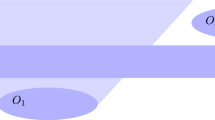Summary
In a previous paper, it was proven that anecessary condition to yield all of the physical consequences of the Pauli exclusion principle is that the nonlinear, closed set of coupled covariant spinor field equations, whose structure is implied by fully exploiting the principle of relativity, entails two of then coupled particle fields thatA) are in the same state of motion,B) have the same inertial masses andC) have a mutaually repulsive electromagnetic interaction. In this paper, it is shown that conditionsA), B), C) aresufficient to yield the Pauli exclusion principle, within the structure of this field theory—thus completing the proof. The general structure of the interaction field amplitude of the nonlinear spinor field theory is then explored further, and the scattering cross-section in defined in terms of it. It is emphasized that, within this field theory, the elementarity of the (predetermined) «interaction» of a closed system is primary, replacing the elementarity of the (nondeterministic) «particle» of an open system, according to the quantum theory. The influence of the Pauli principle on the general form of the scattering cross-section is discussed.
Riassunto
In un precedente lavoro si è provato che una condizionenecessaria per il verificarsi di tutte le conseguenze fisiche del principio di esclusione di Pauli è che il gruppo non lineare e chiuso di equazioni di campo spinoriali accoppiate e covarianti, la cui struttura è implicata dallo sfruttamento del principio di relatività, coinvolge due deglin campi di particelle accoppiati che sonoA) nello stesso stato di moto,B) hanno le stesse masse inerziali eC) hanno una interazione elettromagnetica mutualmente repulsiva. In questo lavoro, si mostra che le condizioniA), B), C) sonosufficienti a dare il principio di esclusione di Pauli nell'ambito della struttura di questa teoria di campo—così completando la prova. Si indaga quindi ulteriormente la struttura generale dell'ampiezza di campo di interazione della teoria di campo spinoriale non lineare e si definisce la sezione d'urto di scattering sulla base di questa. Si mette in evidenza che, in questa teoria di campo, l'elementaritá della «interazione» (predeterminata) di un sistema chiuso è primaria, sostituendo l'elementarità della particella (non deterministica) di un sistema aperto, in accordo con la teoria quantistica. Si discute l'influenza del principio di Pauli sulla forma generale della sezione d'urto di scattering.
Резюме
В предыдущей статье были сфориулированынеобходимые условия для получения всех физических следствий принципа запрета Паули. В этой статье показывается, что эти условия являютсядосмамоцными для получения принципа запрета Паули, т.е. доказательство является завершенным. Используется общая структура амплитуды взаимодействия полей для нелинейной спинорной теории поля. Определяется поперечное сечение рассеяния с помощью этой амплитуды. Отмечается, что в рамках этой теории поля элементарность (заданного) «взаимодействия» для замкнутой системы является первичной, заменяя элементарность (недетерминированной) «частицы» для незамкнутой системы, в соответствии с квантовой теорией. В общей форме обсуждается влияние принципа Паули на поперечное сечение рассеяния.
Similar content being viewed by others
References
This research program has been reported in a series of papers inNuovo Cimento, since (1961). I have published a set of review papers that survey the results, until (1971), inInt. Journ. Theor. Phys.,4, 433, 453 (1971);5, 35, 161 (1972).
M. Sachs:Nuovo Cimento,27, 1138 (1963). It should be noted that the spinor electromagnetic-field terms in eq. (1), that depend on the two-component spinor fieldsϕ α , follow from a factorization of the four-dimensional representation of Maxwell's equations into two uncoupled two-component spinor equations. This formalism revealed all of the standard predictions of the usual Maxwell formalism—in addition to extra predictions that do not at all follow from the standard formalism. One of these is the prediction of the Lamb shift in hydrogen—which turned out to be in good agreement with the experimental data(1). It should be noted, however, that the ensuing proof of the Pauli exclusion principle is not dependent on the explicit appearance of this term. That is, even if we should setg M =0, the result of the proof would still follow—so long as we maintain the fundamental exchange symmetry of this theory between the interacting components of a system. That is it is required that the set of field equations (1) be invariant under the exchangeψ (i) ↔ψ (j). It was shown that this symmetry is a necessary consequence of fully exploiting the principle of relativity, and leads to theessential nonlinearity of this theory.
M. Sachs:Implications of a new approach to quantum electrodynamics in electronproton scattering, inNucleon Structure, edited byHofstadter andSchiff (Stanford, Cal., 1964), p. 336.
Author information
Authors and Affiliations
Additional information
Traduzione a cura della Redazione.
Переведено редакцией.
Rights and permissions
About this article
Cite this article
Sachs, M. Completion of the proof of the Pauli exclusion principle from a self-consistent field theory of electrodynamics. Nuov Cim B 44, 289–298 (1978). https://doi.org/10.1007/BF02726794
Received:
Published:
Issue Date:
DOI: https://doi.org/10.1007/BF02726794




